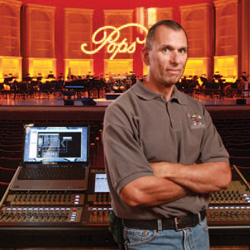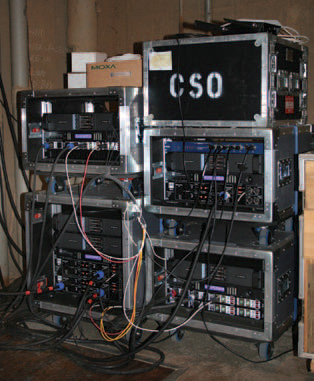
Things change when the system goes to Music Hall. Here, the choice is a single 12-element array, flown centrally in front of a large acoustical structure that extends out from the proscenium.
The arrays have a much more pronounced “J” shape, arching downward in order to cover main floor seating. The 80-degree horizontal dispersion of the array extends coverage very well to the side seating areas.
“Because of the acoustic nature of this venue, the low frequencies can build up pretty easily – 160 Hz will come around and swallow you in a heartbeat, so you have to be smart about it,” LaRocco says.
“We’re running the boxes full-range and will not fly the subs. In rehearsals, the cuts in the LF sound almost cold, but once there’s a crowd, it really warms up.”
The loudspeakers are driven by a Lab.gruppen amplification package, all FP 10000Q 4-channel models, chosen for a number of reasons, including their sonic quality, total-power-to-footprint ratio, and excellent customer support.
In fact, Josh Evans, who recently joined the Lab.gruppen team, was also in attendance for the system debut. The amplifiers are joined in their mobile racks (for convenient transport between the two venues) by HK Audio FIRNet digital loudspeaker processors.
The system also features a new DiGiCo SD8 digital console, which LaRocca selected after some serious homework. He wanted a high channel count, with the SD8 offering 60, and he also sought to implement a digital snake at both venues.

“Just mic’ing the orchestra, along with contacts, takes the channel count up to about 35, and then we need plenty more for our guest artists,” he notes. “You don’t want to make compromises or start sacrificing channels.”
“In addition, I talked with several mixers, including some Broadway people, and they all told me I wouldn’t be disappointed at all with the sound quality of this board. And, at its price point, especially within the context of what we’re trying to achieve, it’s a great fit.”
Pops performances come in two flavors. There’s a more “traditional” setup with a band shell, where the orchestra is not mic’d except for some rhythm players, and then guest artist vocals are amplified and laid over the top.
The other setup is “remix,” where the band shell is removed, black drapes are deployed, and the microphones come out in force.
In remix mode, all instrument sections are mic’d, and then principal players in each section are mic’d so that a little more definition can be added to the mix when needed. In other words, the principals are playing the primary parts, so they provide added emphasis but within the context of area mic’ing of sections.”
“There’s also select contact mic’ing on principals, but it can sound “a bit close,” so it’s applied judiciously. For example, if a drum passage is playing full-bore, the extra gain from the contacts can come in handy in bringing up other vital portions of the mix. But just a bit more.
“I’m not doing anything unusual with the mic’ing, just using quality microphones and taking care with placement,” LaRocco adds. Neumann KM184 small-diaphragm condensers are applied for strings, while most woodwinds are on Neumann KM183 omnidirectional condensers.”
Clarinet and brass some instruments get AKG C 414 large-diaphragm condensers, and Sennheiser MD 441 dynamics handle the horns as well as bass. The harp has an Sennheiser MKE 2 omnidirectional condenser placed inside it, and piano has a combo of a C 414 and an AMT M40 acoustic piano mic system.
For direct needs, LaRocco prefers Radial Engineer JDI passive DI boxes. Overhead, there are pairs of AKG C 451 condensers with CK 1 elements flown about 12 feet above the deck.
Meanwhile, at the console, LaRocco is primarily controlling the overall section sounds. “I look at my role as being an extension of the conductor.
He’s the one really running the sound, so the goal is to capture what he is directing up there as it is happening and naturally amplify it.
“This new system furthers that goal. When we first fired it up, it needed literally nothing – a little EQ but that was it,” he concludes. “Just a comfortable sound, the signature Pops sound, happening just like it does on stage.”
Keith Clark is editor in chief of Live Sound International and ProSoundWeb.
